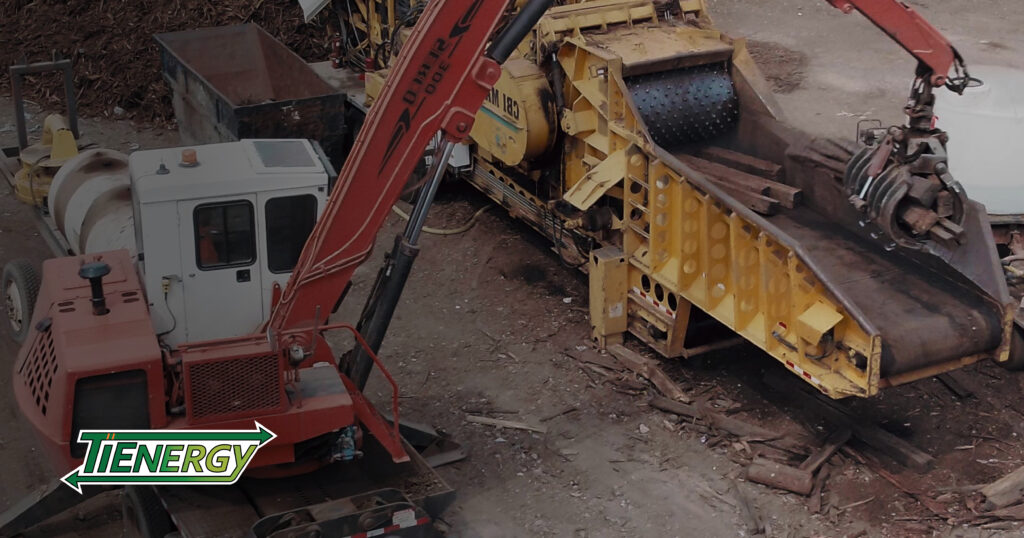RTA member TiEnergy recently celebrated its 20-year anniversary. Founded by Steve and Veronica Berglund, the roots of the company started in 1996, with the TiEnergy concept, name and business entity officially formed in 2002. Crossties caught up with company executives recently for the following question-and-answer article.
Q: When was TiEnergy formed?
The roots of the company started in 1996, and the TiEnergy concept, name, and business entity were officially formed in 2002.
Q: What sparked the idea/need for the company?
The company became involved in wood recycling with its existing construction and demolition recycling facility. Recycling ties seemed like a natural next step and the company was one of the first to have equipment that would stand up to the challenge of and operational needs for chipping and grinding railroad ties. This meant supply was available – but it wasn’t a viable concept without an end-user for the material. An energy company was the first customer, using the material in their power plants, confirming demand for the product. Ties + Energy = TiEnergy was formed.
Q: Who are the principal officers for the company?
Husband and wife duo, Steve & Veronica Berglund are the founders and principal officers of the company.
Q: Where does TiEnergy acquire the ties and other out-of-service wood products for recycling? TiEnergy acquires used railroad ties from Class 1 and other railroads throughout the rail network. There are millions of expired or out-of-service ties that take up space and/or create hazards, and these rail networks need a responsible solution for expired ties and a sustainable alternative to other disposal methods. Additional sources of wood come from existing customers that want to recycle their material via our Construction & Demolition recycling facility.
Q: How does the tie recycling process work?
Ties are placed in railcars and either delivered to TiEnergy’s facility or the company mobilizes to a specific location where a tie contractor has stacked the expired ties in a uniform manner – much like a box of toothpicks. The ties are inspected for any metal plates prior to placing them in our grinder. If needed, proprietary equipment will remove the plates before being placed in the grinder. The ties are then ground up into a shredded consistency. This material becomes feedstock for the landfill product “TIEROC”. The TIEROC product is then loaded into trailers and delivered to landfills throughout the region daily.
Q: What is TiEnergy’s organizational relationship within the Midwest Companies?
Midwest Material Management consists of: the Construction and Demolition recycling facility, a roll-off dumpster service. Midwest Integrated Companies consists of a heavy-duty truck operation, a truck & trailer repair service, and a transportation company with trash hauling capabilities – including 125-yard tipper trailers, 125-yard walking floor trailers, 55-yard end dumps, and log trailers.
Q: Tell us about TIEROC and other products made from used ties and out-of-service wood.
TIEROC supplies many of the region’s major landfills. All landfills need haul roads for trucks to drive on to get through their sites and unload waste. Without TIEROC, trucks easily get stuck, causing major disruptions in operations. TIEROC provides sustainable material for trucks to drive on, which lasts longer than traditional rock / stone and is a more cost-effective solution. This process gives a second life to the ties and provides a more earth-friendly way to recycle them than other alternatives.
Q: What do you see as the future of sustainable tie disposal solutions?
Recycling ties is part of the circular economy. Uses for expired ties have been an issue for decades and the tie piles continue to grow. Expired ties can also take up land space that could be better used for other purposes. We believe the responsible, financially beneficial, and environmentally sustainable solution is TIEROC.
Q: What is the quantifiable environmental benefit of recycling railroad ties?
Our process achieves a savings to the environment with significant amounts of CO2 per tie.
Read the entire article in Railway Tie Association’s magazine, Crossties.
